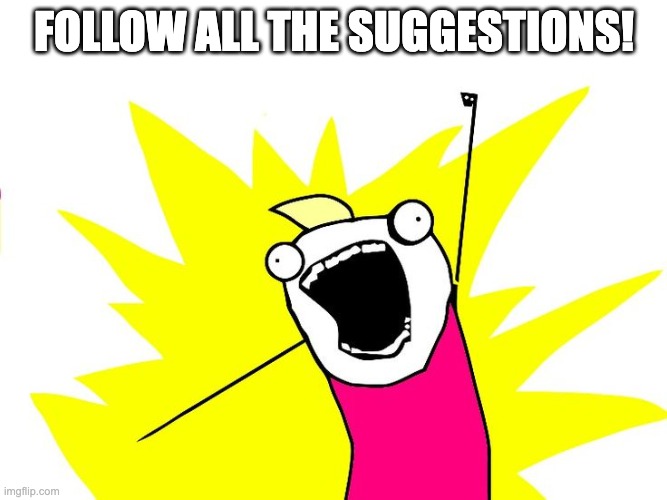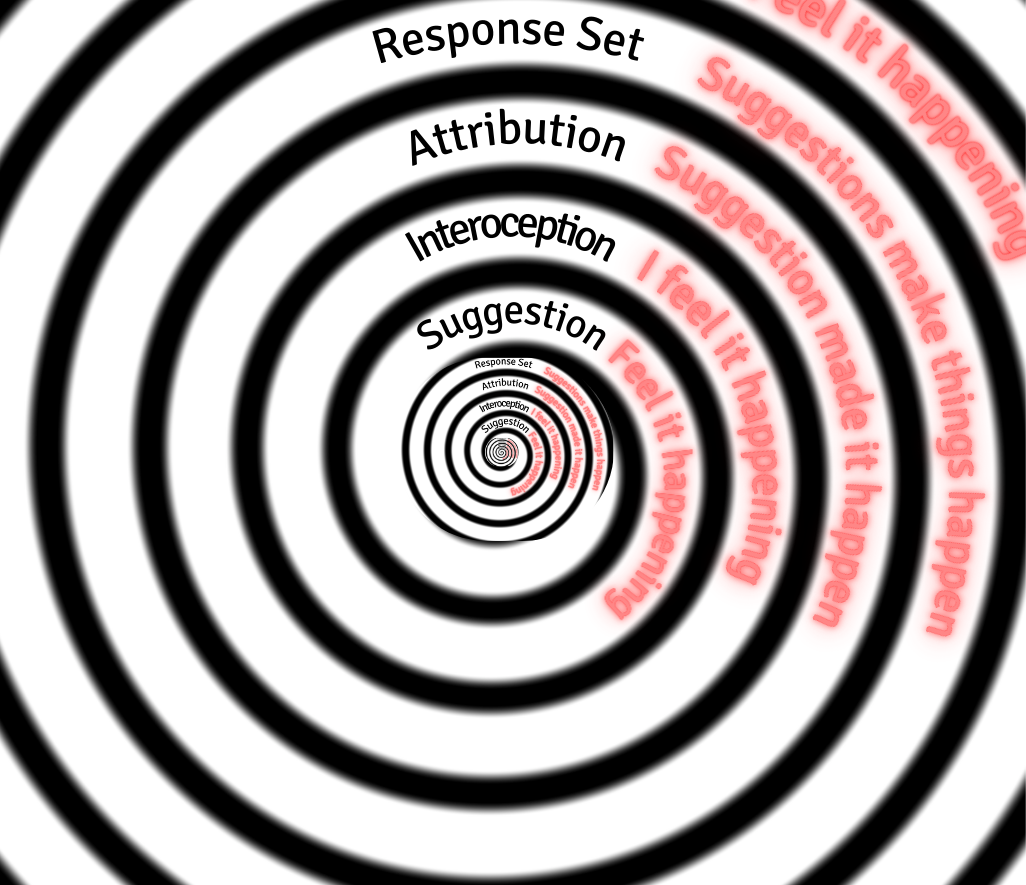Introduction
Getting started covers what hypnosis and suggestions are, how to discuss hypnosis with your partner, negotiating a session, and goes over risks and appropriate behavior.
It’s important to discuss what hypnosis is, what it’s like to be hypnotized, and what suggestions actually do at the very beginning, because this informs the discussion and negotiation.
A Rough Description of Hypnosis
The word hypnosis can mean many different things. The best "newbie" description of hypnosis I can come up with is this:
From a psychology perspective, Simon Says is interesting because it’s about automaticity and response inhibition. A few rounds of Simon Says are all that’s needed to build up a response set (aka "muscle memory") to immediately respond to instructions, and after that point inhibiting the response can become increasingly difficult.
Guided meditation typically involves focused attention, visualizing and imagining what the instructor describes. There may be a focus on the body’s internal state, such as breathing, heartbeat, and muscle tone. Paying attention to the body’s internal state is called interoception and is surprisingly complicated as it involves integration of several different systems. Or the focus may be on metacognition, a recognition of pattern of thoughts such as rumination or unhelpful thought loops. The instructor may give suggestions to relax the body and the mind, asking the meditator to take an active role in regulating those systems, or ask the meditator to believe that they are on a beach or passing an exam.
So, if you imagine a game of Simon Says that involves always following suggestions and building up automaticity so that both physical and mental actions are followed immediately, that’s probably the closest description of hypnosis.
Hypnosis is also like a game in that there’s only a few rules, but both players have to agree to them and agree when the game starts and ends. In hypnosis, this is called the hypnotic contract that determines what the hypnotist can suggest and do, and what the hypnotee commits to adopting a hypnotic mindset and actively following suggestions. While the game is ongoing, there is a hypnotic context — this is a fancy term meaning that both players are playing their roles and focusing on playing the game the way it’s meant to be played.
The Subjectivity of Trance
Hypnotic inductions often involve interoception and metacognition because these systems are complex and ambiguous. There is no line that distinguishes one feeling from another, and it can be easy to confuse one feeling with another. Are you irritated, or are you just hungry and have low blood sugar? Are you depressed, or are you just sleep-deprived? Are you in love, or in lust? There’s often no clear way to tell with internal states, and we have to interpret it based on past experience and awareness.
In subjective experiences, there are no binaries: there is no hungriness switch that goes from "hungry" to "not hungry." Instead, there’s a range of sensations and input over multiple dimensions that we can recognize as hungriness. In just the same way, there is no "trance" switch in the brain that will tell you definitively you are hypnotized.
Like flow, trance is an inherently subjective experience that brings together focused attention, dissociation, and rapport. Like other subjective experiences, there is no distinguishing line that separates trance from other mental states, and so many people’s first experience with trance may involve self-questioning that they are actually in a trance or are hypnotized, especially if they have ideas that hypnosis is a state of sleep. In reality, trance is more of a state of creative problem-solving and processing than a state of half-dreaming idleness. If you were to look at someone who is hypnotized, you would think that they were asleep or "zoned out" and not sure of what was going on. This is misleading; you are looking at someone who is very focused on following the suggestion that they relax. Counter-intuitively, they are relaxing as hard as they can.
It’s important to note that trance is only one of many possible experiences available during an induction. While trance inductions are the most common, different varieties of induction focus on alertness, focus, imagery, or even confusion and dissociation. Although trance is by far the most common experience, trance is not hypnosis itself. See What is Hypnosis for a more in-depth discussion.
Explore Experiences
The experience of trance is also a good introduction to how to manage expectations and goals in hypnosis. Look for multidimensional ranges of experience, and explore what you feel. Don’t get hung up on binaries such as "trance or bust" or "pass/fail suggestions" because that doesn’t take into account what you experienced and what did work. Look for attainable goals. Likewise, if you are the hypnotist, be curious and nonjudgemental about responses, and take them as feedback and input for the next suggestion.
For example, some hypnotic inductions involve being blank and mindless or free from thoughts and doubts. Thoughts happen. Trance doesn’t preclude thoughts, and being completely free from thoughts is not a realistic expectation. Instead, suggestions involve inhabiting that experience of being blank and mindless, and coming as close to it as possible. Twohypchicks has a great podcast talking about accepting that thoughts can come and go and letting go of binary mindsets.
Likewise, hypnosis can feel deep and compelling, or it can feel like the mind is racing. There are times that people will need breaks. Sometimes it’s not working, and it’s much better to tap out, breathe, and check-in rather than try to force it.
What Does It Mean To Be Deeply Hypnotized?
Trance is a subjective feeling, but research on hypnotic virtuosos shows that deep hypnosis is possible involving an alteration of consciousness with distinct modes, rather than variations of intensity. Some people may feel focused entirely on the hypnotist’s words. Some people may feel like they are very disconnected from their bodies. Some might lose their sense of time, or even have small flashes of images or see bright light.
Most people are not hypnotic virtuosos, and deepening trance may feel more like hypnogogic phenomena such as fragmented thoughts. It’s very common for newbie hypnotists to accidentally put their hypnotees to sleep unintentionally while deepening trance.
Deepening trance in itself does not make suggestions easier to follow, or unlock new abilities in the mind. Some deepeners do include suggestions to remove self-critical or analytic thought or open the mind to new possibilities, and these can have an effect, but these suggestions are not an intrinsic part of deepening itself.
Given that depth of trance does not help with following suggestions, you might wonder why people keep using deepeners if they’re not useful. And the answer is because it’s recreational hypnosis and deepening is fun. The experience of deep trance does not require utility, and it’s perfectly okay to do things for the kick of it.
The Exercise of Suggestions
In Simon Says, the skill in the game is immediately following the instruction or inhibiting it completely from one round to the next. In hypnosis, the skill in the game is in following suggestions that involve more and more control over perception and experience. Hypnosis involves the active involvement and participation of the hypnotee. Paraphrasing the Carleton Skill Training Program:
If you just sit and wait for suggested responses to happen on their own, nothing will happen. Make the responses that are suggested, but pay no attention to the fact that you are making them. Instead, devote your full, undivided, and continuous attention to the stories.
This is easier than it sounds, because there is really only one high level implementation intention: If I am given a suggestion, I will follow it automatically. By holding onto that high level intention consciously, following the lower level suggestions is about implementing that intention.

Actively following suggestions and encouraging automatic behavior builds up a response set. Each followed suggestion tells the brain that the behavior follows the suggestion and nudges it towards automatically following suggestions.
Building and working on automatic behavior is common in all skill-building. If you think about learning to touch-type or driving a car, at first everything was conscious, error-prone, and awkward. It wasn’t until you were immersed in the activity that things started to "click" and it felt more natural. In the same way, following suggestions is a skill that can take practice before it begins to feel automatic. The behavior may even become involuntary, e.g. we learn as children how to recognize words and now find word recognition involuntary.
Hypnotic inductions, when you look at them closely enough, break down into a series of suggestions and feedback loops that validate those suggestions. When starting hypnosis for the first time, it’s common for people to be slightly nervous and confused, because they’ve never done this before. The hypnotist tells them to do physical activities that will cause relaxation and co-regulates with them through pacing (talking slowly and calmly) and mirroring (positioning with them and reflecting their body language). The hypnotist usually tells them to take deep breaths, relax their muscles, and notice that their arms and legs can feel heavy. All of those things together are calming influences. The hypnotist is giving suggestions.
Just out of ambiguity, people are likely to recognize a little relaxation in the body because that’s always an element in internal state, and focusing on an internal state makes it more real. As their nervousness fades, and they concentrate on following the suggestion of relaxation, they notice that they are more relaxed. This is interoception. They attribute their increased relaxation to the suggestion. This validates the expectation and sets up the brain in a response set that hypnotic suggestions can make things happen. Finally, the response set causes increased suggestibility where subsequent suggestions to be more effective and easily followed.
You can think of this process as a four stage spiral, where each established response set leads into a new suggestion:
-
Suggestion: "You feel something happening."
-
Interoception: "I feel it happening."
-
Attribution: "Suggestion made it happen."
-
Response Set: "Suggestions make things happen."

At some point in a progressive muscle relaxation induction the hypnotist will finish by saying "the body is completely relaxed." At this point, the hypnotee is "warmed up" and suggestible — they have successfully followed several suggestions and may feel some automaticity or involuntariness in their responses.
Can Hypnosis Make You Do Things You Don’t Want To Do?
This question is covered in the risks section under abuse, but it’s worth bringing up here and now.
By itself, a blatant suggestion has a very high chance of being rejected. Trance is typically a lucid awareness and incorporates a conscious high-level agreement to follow suggestions. An inappropriate suggestion will break that agreement. There are some people who are extremely suggestible and have difficulty resisting even inappropriate suggestions, but they are very rare. (You should never rely on this and always negotiate suggestions in the pretalk to minimize unpleasant surprises.)
However, hypnosis can change what you want to do. Some hypnosis books from the 1970s describe a "hidden observer" or "subconscious mind" that protects you from bad suggestions, but this has since been discredited.
Again, think of a series of nudges. A single session of hypnosis can’t make you do something you don’t want to do, but it might nudge you in the direction of thinking about it. Multiple sessions of hypnosis could nudge you to not hating the idea, to eventually liking it. Hypnotherapy works essentially like this when removing phobias and changing behaviors.